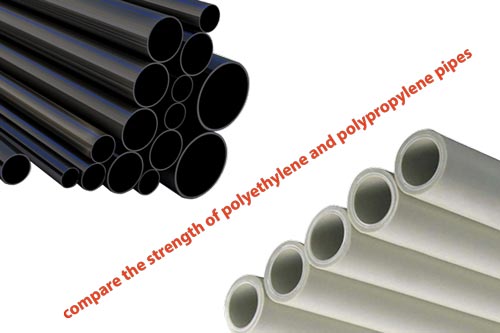compare the strength of polyethylene and polypropylene pipes

Polyethylene and polypropylene are two of the most commonly used plastic materials in the world. They have a wide range of applications, including in the pipe industry. In this article, we will compare the strength of polyethylene and polypropylene pipes.
To begin, let's take a look at the mechanical properties of these two materials. Polyethylene is known for its toughness and flexibility, while polypropylene is known for its stiffness and strength. When it comes to pipes, these properties can have a big impact on their performance.
In general, polyethylene pipes are more flexible and can withstand more deformation than polypropylene pipes. This means that they are less likely to break or crack under stress, making them a good choice for applications where the pipes will be exposed to high levels of strain or bending.
On the other hand, polypropylene pipes are stronger and more rigid, making them better suited for applications where high levels of pressure or impact are expected. They are less likely to deform or buckle under pressure, making them a good choice for applications where the pipes will be carrying heavy loads or exposed to harsh environments.
Another important factor to consider when comparing the strength of polyethylene and polypropylene pipes is their environmental stress crack resistance. This is a measure of how well the material can resist cracking or breaking when exposed to stress over time.
In this regard, polyethylene has a clear advantage over polypropylene. Polyethylene pipes are highly resistant to stress cracking, even when exposed to harsh chemicals or extreme temperatures. Polypropylene, on the other hand, is more prone to stress cracking, especially when exposed to chemicals or high temperatures.
There are also other factors that can affect the strength of polyethylene and polypropylene pipes. For example, molecular weight and molecular weight distribution can have a big impact on the overall strength and durability of these materials.
Higher molecular weight and a more uniform distribution of molecular weight can improve the strength and toughness of both polyethylene and polypropylene. Temperature and time are also important factors to consider, as exposure to high temperatures over time can weaken the material and reduce its overall strength.
When it comes to applications and selection, both polyethylene and polypropylene have their advantages and disadvantages. Polyethylene is typically less expensive and more flexible, making it a good choice for applications where cost and flexibility are important factors. It is commonly used in water supply and drainage systems, as well as for gas and chemical transportation.
Polypropylene, on the other hand, is more expensive but stronger and more rigid, making it a good choice for applications where strength and durability are important factors. It is commonly used in high-pressure water and gas distribution systems, as well as in industrial and chemical processing applications.
When selecting between polyethylene and polypropylene pipes, there are several factors to consider. These include the application, the expected lifespan of the pipes, the level of stress they will be exposed to, and the cost. It's important to choose the material that best suits the specific needs of the project, in order to ensure optimal performance and longevity.
In conclusion, the choice between polyethylene and polypropylene pipes ultimately depends on the specific needs of the project. While both materials have their advantages and disadvantages, understanding the differences in strength and durability can help make the decision easier. As the industry continues to evolve and new research is conducted, we may see even more innovations and advancements in these materials in the future.